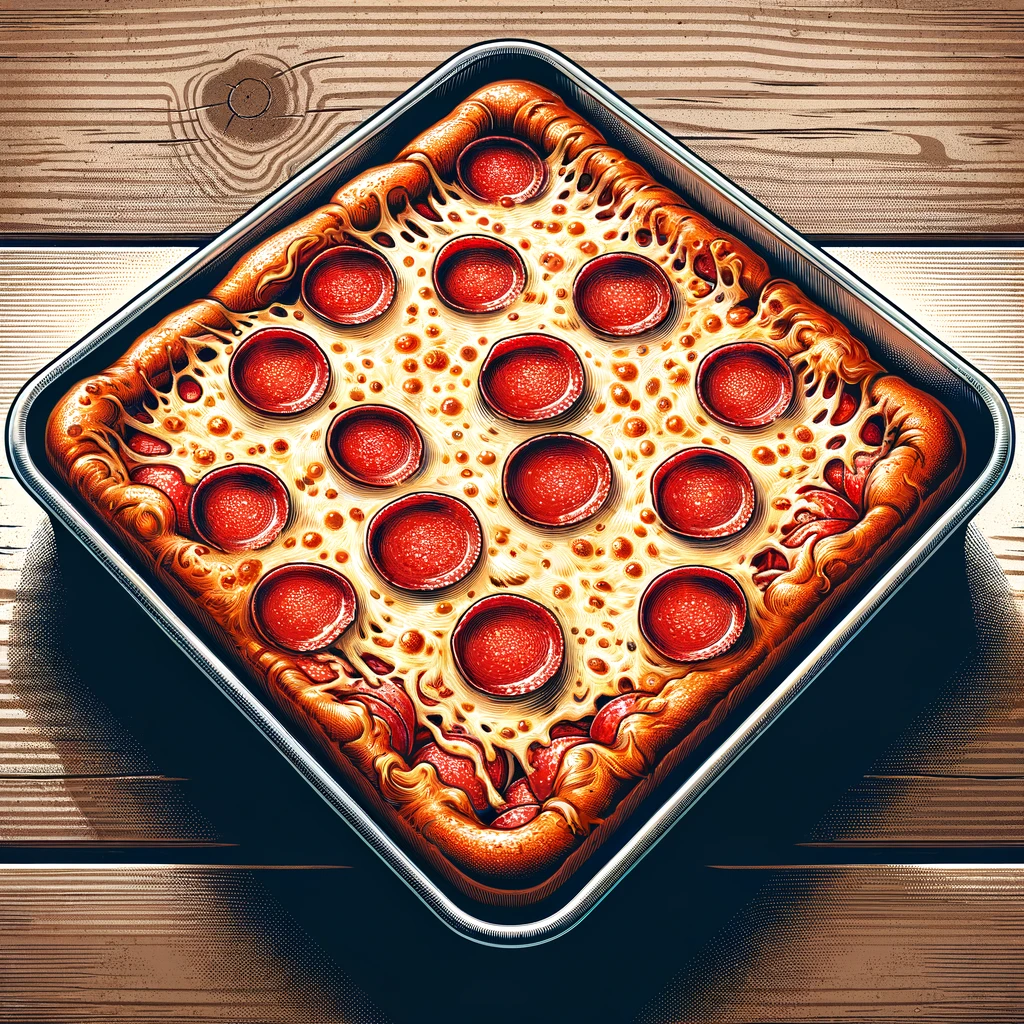
Detroit-style pizza has emerged as a beloved variant in the world’s vast pizza landscape, captivating food enthusiasts with its unique characteristics and mouthwatering taste. Originating from Detroit, Michigan, this pizza style is distinguished by its square shape, thick crust, and a delightful layer of cheese that crisps up around the edges. In this comprehensive article, we delve into the essence of Detroit-style pizza, exploring what sets it apart from its counterparts and why it has garnered such a passionate following.
The Unique Attributes of Detroit-Style Pizza
The Crust
At the heart of every Detroit-style pizza is its crust. Unlike the thin, flexible crusts of its New York or Neapolitan counterparts, Detroit pizza boasts a thick, fluffy, yet crispy base. The secret lies in the dough’s high hydration level, combined with a slow fermentation process that yields a light and airy texture. Baked in a square, steel pan – originally used in automotive factories – the crust achieves a caramelized cheese edge that is irresistibly crunchy and flavorful.
The Toppings
Toppings on a Detroit-style pizza are layered distinctively, starting with generous portions of pepperoni placed directly on the dough. Cheese is then scattered to the very edges of the pan, ensuring a melt-in-your-mouth experience with every bite. Unlike other pizza styles where cheese is sprinkled on top, in Detroit-style pizza, the sauce is ladled over the cheese in thick stripes. This not only prevents the dough from becoming soggy but also adds a vibrant, tangy contrast to the rich, gooey cheese and crispy crust.
The Cheese
A hallmark of Detroit-style pizza is the use of Wisconsin brick cheese, a semi-soft cheese known for its high-fat content and excellent melting properties. This cheese is spread edge-to-edge, creating a caramelized cheese border that is a signature of the style. Its slightly tangy flavor complements the sweet tomato sauce and spicy pepperoni, making each slice a harmonious blend of textures and tastes.
The Sauce
The sauce used in Detroit-style pizza is another defining element. It is typically a smooth, herb-infused tomato sauce that is applied in thick lines across the top of the cheese. This method, known as “striping,” ensures that the sauce doesn’t overwhelm the other components, allowing each ingredient to shine.
FAQs: Unwrapping the Mysteries of Detroit-Style Pizza
What Makes a Pizza Detroit-Style?
Detroit-style pizza is characterized by its square shape, thick and airy crust, edge-to-edge cheese, and the distinctive striping of sauce over the toppings. The use of a steel pan for baking is also a key factor, as it aids in creating the signature crispy, caramelized cheese border.
What is the Difference Between Detroit-Style Pizza and Regular Pizza?
The main differences lie in the crust, cheese, and baking method. Detroit-style pizza has a thicker, airier crust compared to the thinner crusts of traditional pizzas. The use of brick cheese up to the edges, resulting in a crispy cheese perimeter, and the late addition of sauce in stripes distinguish it from other styles.
Why is Detroit Pizza So Good?
The allure of Detroit pizza comes from its perfect balance of textures and flavors. The crispy, chewy crust, coupled with the creamy melt of brick cheese and the bright acidity of the tomato sauce, creates a multi-dimensional taste experience. The caramelized cheese edges add an addictive crunch that pizza lovers can’t resist.
What is the Difference Between Detroit and New York Pizza?
Detroit pizza is square with a thick, airy crust, while New York pizza is typically round with a thin, foldable crust. Detroit uses brick cheese and has a layer of sauce on top, whereas New York Pizza is known for its mozzarella and sauce beneath the cheese. The baking methods also differ, with Detroit-style pizzas baked in square pans and New York pizzas traditionally cooked on the oven floor.
How to Make Homemade Detroit-Style Pizza
Detroit-style pizza, with its crispy crust, cheesy edges, and unique layering, has won the hearts of pizza lovers everywhere. Making it at home is an exciting culinary project that brings a taste of Detroit right into your kitchen. Here’s how you can create this delicious dish from scratch.
Ingredients
For the Dough:
- 2 cups (240g) all-purpose flour
- 1 teaspoon (5g) sugar
- 1 teaspoon (5g) salt
- 1 teaspoon (3g) instant yeast
- 3/4 cup (180ml) lukewarm water
- 2 tablespoons (30ml) olive oil, plus more for greasing
For the Toppings:
- 2 cups (about 300g) Wisconsin brick cheese, diced or shredded
- 1/2 cup (about 120g) pepperoni slices
- 1 cup (240ml) pizza sauce (homemade or store-bought)
- Optional: onions, mushrooms, or any other preferred toppings
For the Sauce (If Making from Scratch):
- 1 can (28 ounces) crushed tomatoes
- 1 teaspoon (5g) salt
- 1 teaspoon (5g) sugar
- 1 teaspoon (2g) garlic powder
- 1 teaspoon (2g) dried oregano
- 1/2 teaspoon (1g) dried basil
- 1/2 teaspoon (1g) red pepper flakes (optional)
Instructions
1. Prepare the Dough:
- Mix the Dough: In a large mixing bowl, combine the flour, sugar, salt, and instant yeast. Gradually add the lukewarm water and olive oil, mixing until a sticky dough forms.
- Knead: Transfer the dough to a lightly floured surface and knead for about 5 minutes, or until it’s smooth and elastic.
- First Rise: Lightly oil a bowl and place the dough inside, covering it with a damp cloth. Let it rise in a warm place for about 1-2 hours, or until it doubles in size.
2. Prepare the Pan:
- Grease the Pan: Generously oil a rectangular metal pan (traditionally, a 10×14-inch steel pan) with olive oil. This helps create the pizza’s signature crispy bottom and edges.
- Shape the Dough: Gently press down the dough to deflate it, then transfer it to the prepared pan. Stretch the dough to cover the bottom of the pan, taking care not to tear it. If the dough springs back, let it rest for a few minutes before stretching again. Cover and let it rest for another 15-20 minutes.
3. Add Toppings:
- Layer the Cheese: Spread the diced or shredded cheese evenly over the dough, making sure to reach the edges. This will create the characteristic crispy cheese border.
- Add Pepperoni: Distribute the pepperoni slices (and any other desired toppings) evenly on top of the cheese.
- Apply the Sauce: Dollop the pizza sauce in three stripes across the pizza. For a more authentic touch, prepare the sauce by simmering the sauce ingredients until thickened, then cooling before applying.
4. Bake the Pizza:
- Preheat Oven: Preheat your oven to 475°F (245°C).
- Bake: Place the pizza in the oven and bake for about 15-20 minutes, or until the cheese is bubbly and the edges are golden brown and crispy.
- Cool and Serve: Let the pizza cool in the pan for a few minutes before transferring it to a cutting board. Cut into squares and serve hot.
Additional Tips
- Cheese to the Edges: For that iconic crispy cheese edge, ensure the cheese is spread all the way to the sides of the pan.
- Customize Your Toppings: Feel free to add your favorite toppings. Just remember to keep the sauce on top for that authentic Detroit-style experience.
- Pan Choice: If you don’t have a traditional Detroit-style pan, a similar-sized cake pan or even a cast-iron skillet can work as alternatives.
Conclusion
Detroit-style pizza is more than just a regional specialty; it’s a testament to the innovation and cultural melting pot of Detroit. With its unique combination of a crispy, chewy crust, edge-to-edge cheese, and distinctive sauce application, Detroit-style pizza offers a deliciously unique take on the traditional pizza experience. Whether you’re a long-time fan or a curious foodie looking to expand your pizza palate, Detroit-style pizza is a must-try that promises to deliver satisfaction in every bite.
